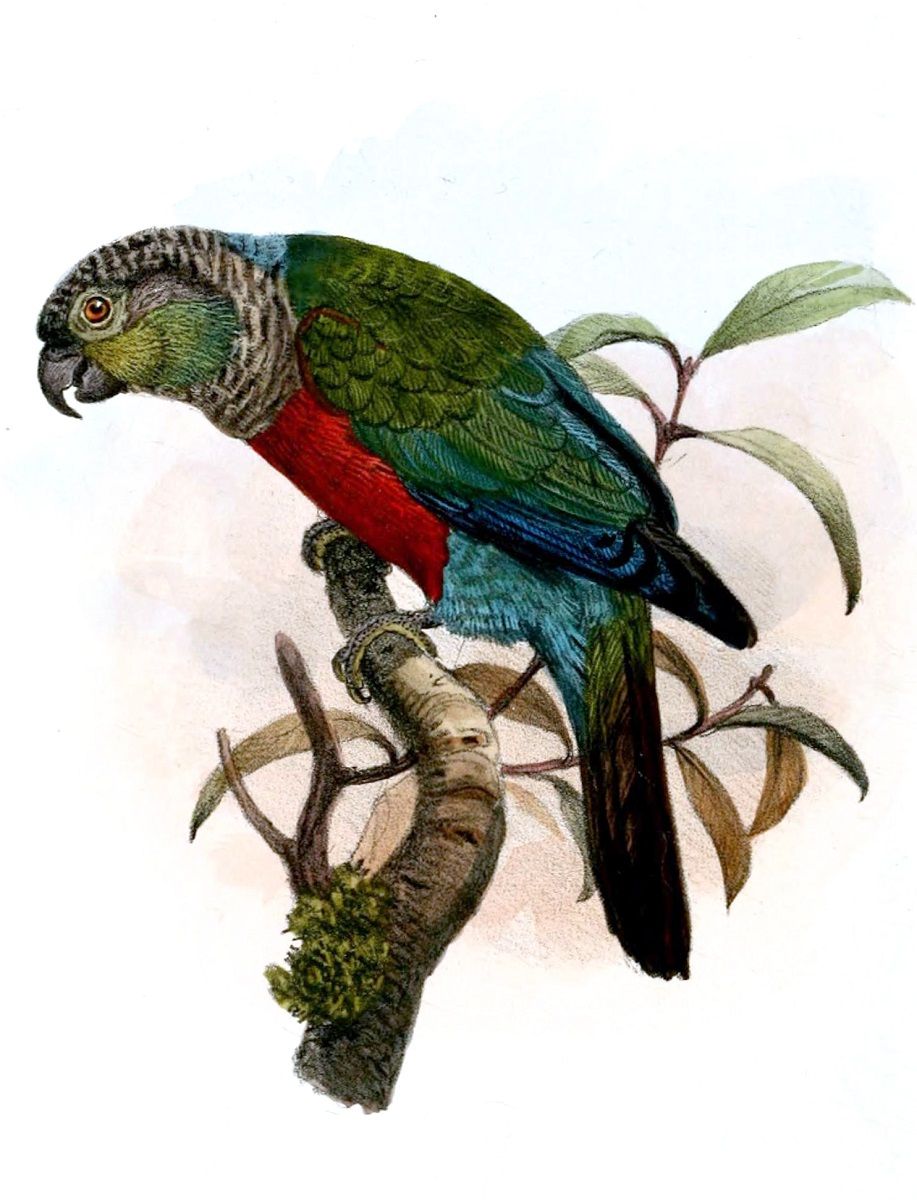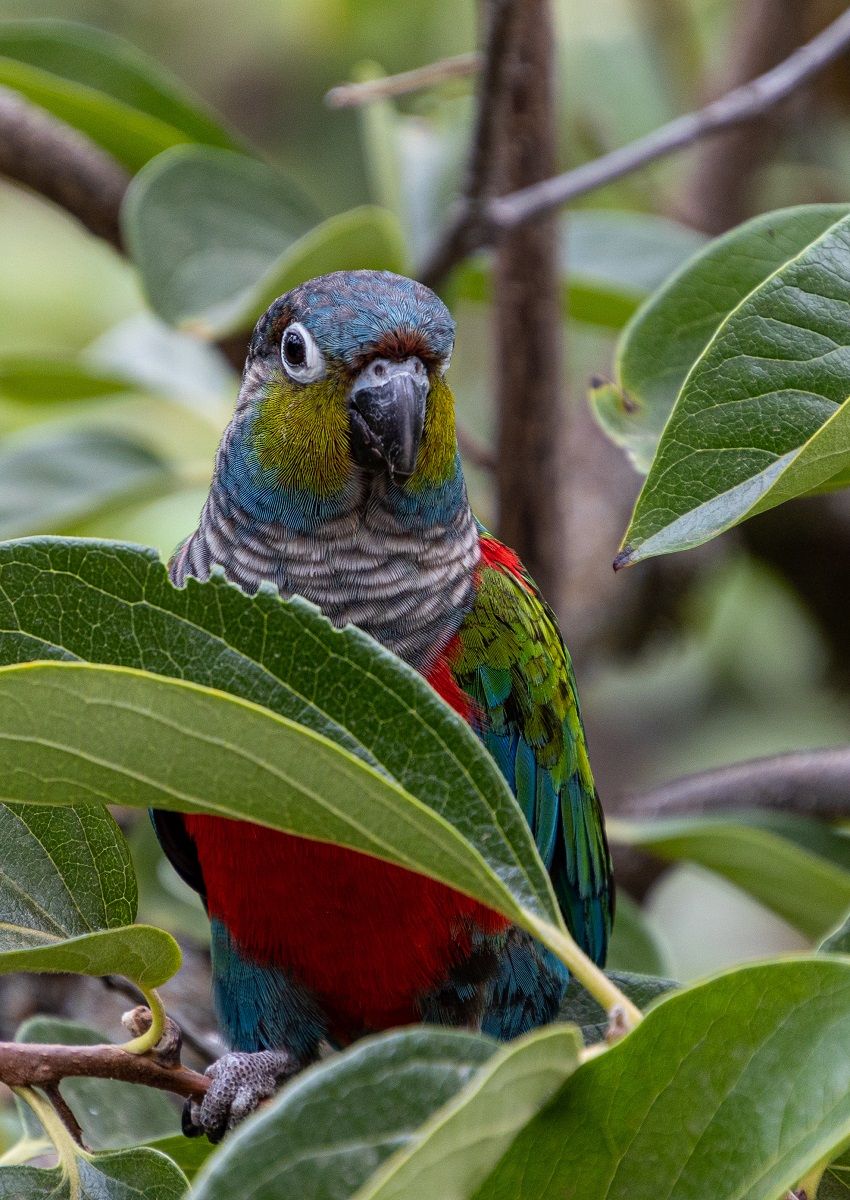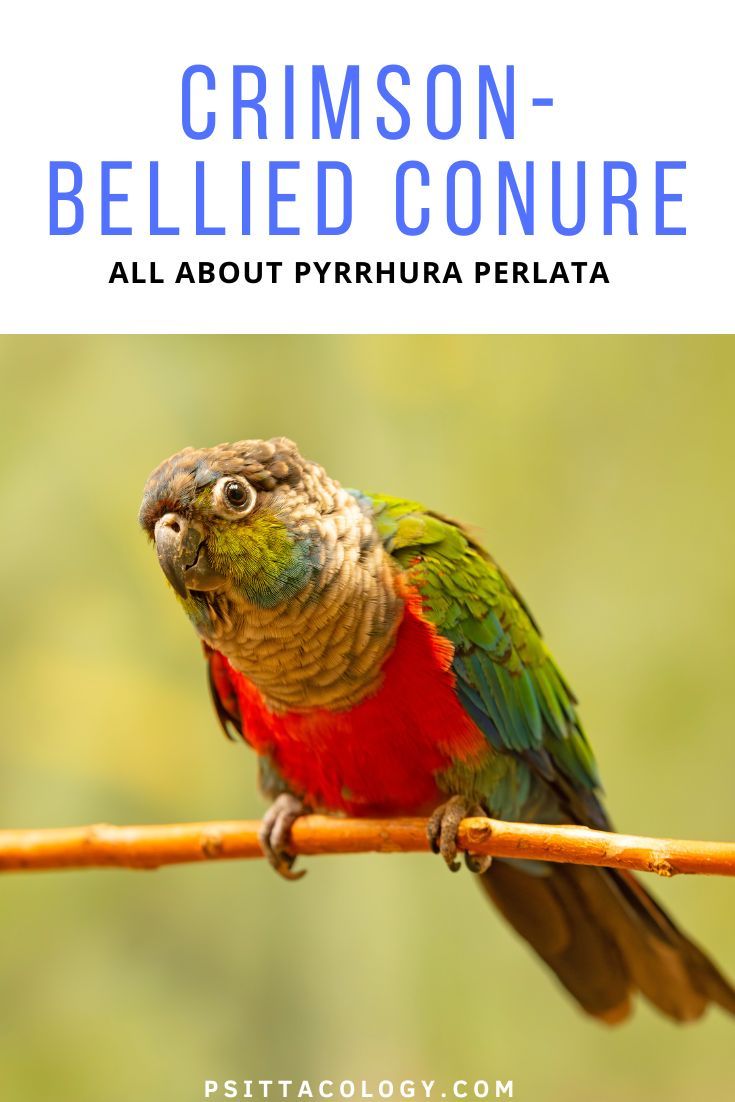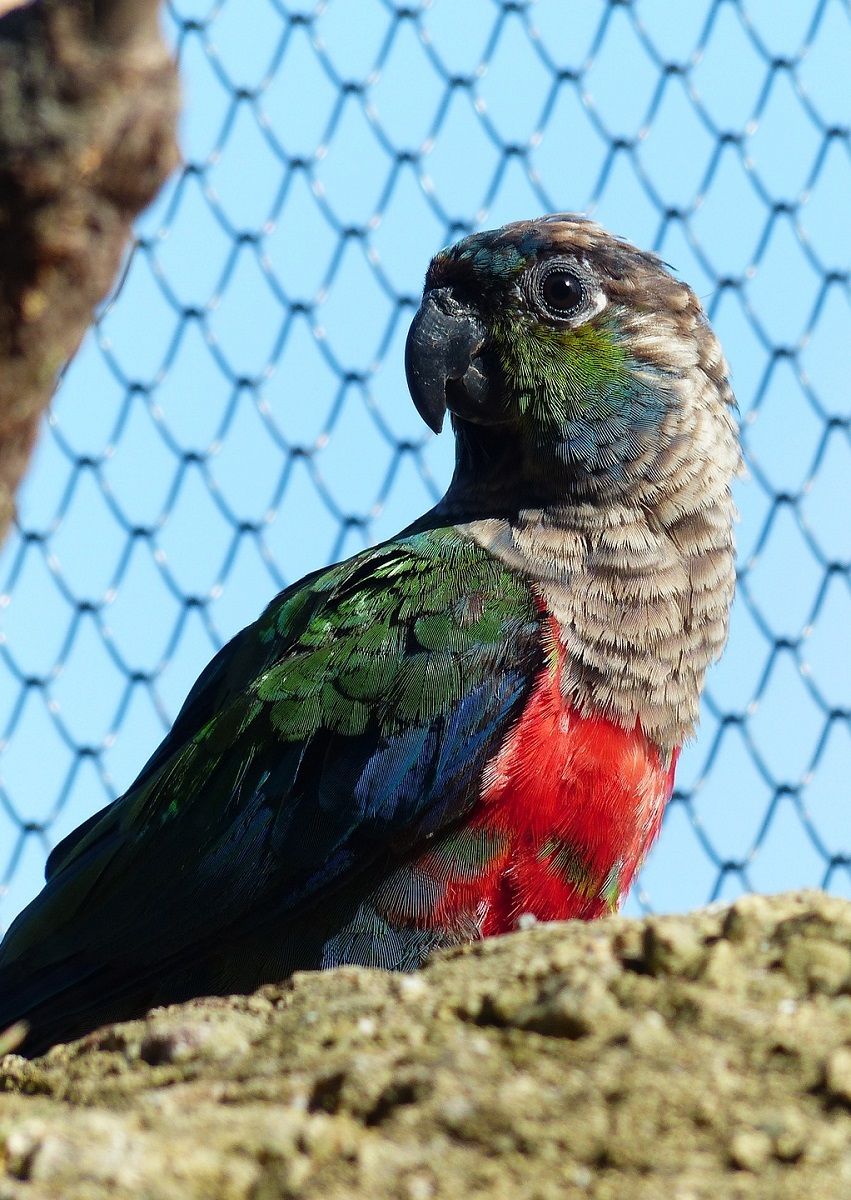Looking for a small parrot to add to your family? If you don’t mind a little craziness, the clownish but friendly crimson-bellied conure may be just the bird for you.
Don’t forget to do your research first: below, you’ll find everything you need to know about crimson-bellied conures, from their origins and wild diet to how to care for one in your home.
| Name(s) (common, scientific) | Crimson-bellied conure, crimson-bellied parakeet, Pyrrhura perlata |
| Natural habitat | Brazilian Amazon basin, northern Bolivia |
| Adult size | Up to 10″ (25 cm) in length, 90 grams |
| Lifespan | 20+ years |
| Noise level | Low-Medium |
This post contains affiliate links. If you make a purchase, a small percentage will go directly to Psittacology at no additional cost to you. Thank you for supporting Psittacology!
Crimson-bellied conure appearance
Where do I start? Even among parrots, the crimson-bellied conure is exquisitely colorful. As the name suggests, its belly is indeed a very vibrant shade of red, but it doesn’t stop there:
- The cheeks are blue and bronze-green.
- The crown is blue.
- Some brownish-red coloration right above the beak and behind the eyes.
- The wings are blue and green, fading into bronze on the back.
- The tail feathers are dark red.
This is a small, long-tailed parakeet species that reaches around 10″ (25 cm) in length and can weigh up to 90 grams. It sports white eye rings and a black beak.
Keep in mind that it can take up to a year for crimson-bellied conures to develop their typical bright red bellies. Unfortunately, it’s not possible to visually tell the difference between males and females of this species.

Crimson-bellied conure range & natural habitat
Range
The crimson-bellied conure is naturally found in central South America. The species mostly occurs in the Brazilian Amazon Basin, especially in the state of Rondônia, although its range also extends into northern Bolivia.
In its natural habitat, this conure can mostly be found in lush rainforests that don’t experience seasonal flooding, also known as terra firme forest. They’re not too picky, inhabiting both dense forest and forest edges, as well as secondary forest.
Wild crimson-bellied conures, like most parrots, mostly travel in small groups. They sometimes mix with other conure species, like the painted conure. The species nests in hollow trees.
The IUCN Red List considers Pyrrhura perlata to be a species of Least Concern in its natural habitat. It does note the population is on the decrease due to deforestation and hunting.

Crimson-bellied conure diet
Wild diet
The forests these conures inhabit in the wild are incredibly biodiverse, so they’ve adapted to feed on a variety of different foods. Like many other rainforest parrots, they like wild figs and other fruits.
Aside from fruit, crimson-bellied conures have been spotted feeding on flowers and catkins. They also visit clay licks, where they eat soil in order to obtain important micronutrients and minerals.
Captive diet
Your pet crimson-bellied conure needs a varied diet to thrive. You can feed daily portions of high-quality pellets as a staple—Psittacology’s resident veterinarian Dr. Daisy and other avian vets recommend against a seed-based diet, as this can lead to malnutrition.
In addition to a nutritionally complete pellet food, offer fresh veggies daily, fresh fruit regularly, and other suitable foods like cooked grains (whole-wheat rice, quinoa), pesticide-free foraged grasses, and occasional treats like sunflower seeds.
Of course, your crimson-bellied conure should have 24/7 access to fresh water, preferably from multiple sources.
A healthy diet is the key to a happy and long-lived parrot, so be sure to check out the full post on parrot diet to learn more!

Crimson-bellied conure housing
Although crimson-bellied conures aren’t very big as far as parrots go, they are highly active. Your best bet is to get your bird the largest cage you can accommodate, especially if it won’t be able to spend the majority of the day flying free.
A 36″ (90cm) wide cage should be the minimum unless the cage door is always open while your parrot is awake. If you don’t want to let it out at all, you’ll need to set up a full (indoor) aviary.
The cage should contain a variety of natural wood perches—plastic and dowel sticks can damage your bird’s feet in the long run. It should also have plenty of toys, which we’ll discuss below.
Crimson-bellied conure enrichment
All parrots are intelligent beings that need plenty of mental stimulation to keep them happy and healthy. Crimson-bellied conures love to play with toys, their human family, and their own kind.
Boredom can cause severe stress, which in turn can lead to problems like excessive screaming, feather plucking, obesity from a lack of moving around, and even aggression. So keep that bird busy!
Here’s how you do it:
- Let your crimson-bellied conure out of its cage at least a few hours a day. You can install a play gym on top of the cage to give it a place to hang out.
- Interact with your bird. Allocate time for training, play, and just hanging out.
- If you work a regular 9-5 job, I strongly recommend getting two conures. I can’t stress enough how social these birds are!
- Buy or DIY lots of conure toys. They don’t have to be fancy, but it’s a good idea to rotate them regularly so they stay interesting.
- Consider offering foraging opportunities like a foraging box.
Tip: Any room that your conure has access to should be safe for birds. You can read more in the post on parrot-proofing a space.

Crimson-bellied conure temperament
Conures of the Pyrrhura genus are among the most popular parrots to keep as pets. Green cheeks are more common, but I think crimson-bellies can also make an excellent choice for the right owner.
I refer to this species as “loveable rogues” for a reason: they’re fun and very cheeky, but a well-socialized bird will also love to cuddle up on your shoulder and receive head scratches.
If you’re looking for a friendly but clownish addition to your family, a crimson-bellied conure may be for you. Sure, you can count on some of your belongings being chewed up, but if you don’t mind a little chaos, they can make great friends for decades to come.
Tip: Like all parrots, these curious conures have a knack for getting themselves in trouble. It’s no fun to think about, but you should read up on parrot emergency care just in case.
Crimson-bellied conure sounds
As far as conures go, crimson-bellies are far from being the loudest. They’re by no means quiet, however—no parrot is. Although they don’t vocalize as much as many other species, you can expect screams when your bird is excited or upset.
It’s important to make sure you can handle the noise before adding any parrot to your family. Check out the crimson-bellied conure’s calls at xeno-canto and consider visiting someone who owns one to have a good listen.
Can crimson-bellied conures talk?
Well… most parrots, including this one, have a knack for imitation. Pyrrhura conures aren’t considered very talented, though. Many never learn to talk, although you can expect them to mimic household sounds.
Here’s an example:
Frequently asked questions
With a good dose of luck and the guidelines discussed in this care guide, your crimson-bellied conure can live 20+ years. Don’t take adopting one lightly, as they’re a decades-long commitment!
If you have any more questions about crimson-bellied conures or if you’d like to share your own experiences with these colorful South American parrots, don’t hesitate to leave a comment below!
Sources & further reading
- Parr, M., & Juniper, T. (2010). Parrots: a guide to parrots of the world. Bloomsbury Publishing.
- Van Hoek, C. S., & King, C. E. (1997). Causation and influence of environmental enrichment on feather picking of the crimson‐bellied conure (Pyrrhura perlata perlata). Zoo Biology: Published in affiliation with the American Zoo and Aquarium Association, 16(2), 161-172.

